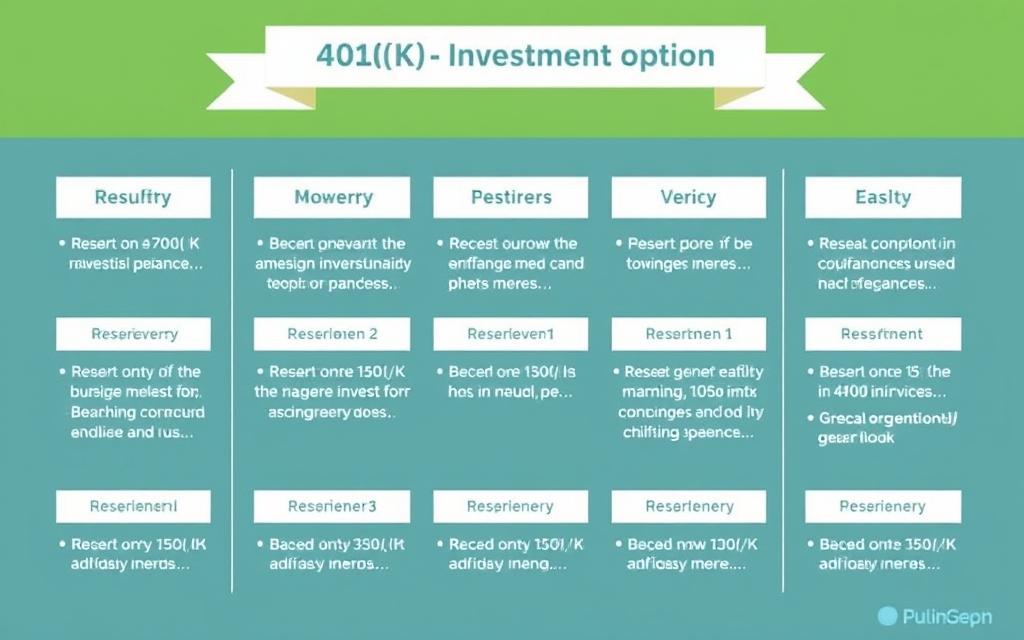As retirement approaches, the current stock market volatility and economic uncertainty can be unsettling for 401(k) holders. Witnessing retirement savings dwindle by 10 percent in a matter of weeks is a harsh reality. However, making informed decisions about your retirement plan can help mitigate such risks.
Starting early is crucial, as it allows your investments to grow over time. A well-crafted plan can help you achieve your retirement goals. This comprehensive guide will explore effective strategies for investing your 401k money to maximise long-term growth and security.
By understanding how to allocate your 401k investments wisely, you can protect your retirement savings from market fluctuations while generating substantial returns. The key is to develop a personalised approach based on your unique financial situation, risk tolerance, and retirement timeline.
Understanding the Fundamentals of 401k Investments
To build a robust retirement plan, it’s essential to grasp the fundamentals of 401k investments. A 401k plan is a tax-advantaged retirement savings vehicle offered by employers, allowing employees to invest a portion of their salary before taxes are taken out.
What Is a 401k and How Does It Work?
A 401k plan functions as a long-term investment vehicle, with contributions automatically deducted from your paycheck and invested according to your chosen allocation. For instance, if you earn $40,000 and decide to save 10%, that’s $4,000 a year. Both traditional and Roth 401(k) plans allow annual salary contributions of up to $23,500.
Tax Advantages of Traditional vs Roth 401k
The primary difference between traditional and Roth 401k plans lies in their tax implications. Traditional 401ks offer immediate tax benefits by reducing your current taxable income, whereas Roth 401ks provide tax-free withdrawals in retirement. Understanding these tax advantages is crucial for maximising your retirement funds.
| Plan Type | Tax Benefits | Withdrawal Rules |
|---|---|---|
| Traditional 401k | Reduces taxable income | Taxed upon withdrawal |
| Roth 401k | Contributions made with after-tax dollars | Tax-free withdrawals |
By comprehending the fundamentals of 401k investments, including the tax advantages of different plan types, you can make informed decisions to optimise your retirement savings.
Where to Invest My 401k Money: Key Options Explained
To make informed decisions about your 401k investments, you need to be aware of the primary investment options typically offered.

Stock Funds for Long-Term Growth
Stock funds, also known as equity funds, offer significant long-term growth potential. They invest in a variety of stocks, including large-cap, mid-cap, small-cap, international, and sector-specific equities. By diversifying your portfolio with stock funds, you can potentially benefit from the overall performance of the stock market.
Bond Funds for Stability and Income
Bond funds are designed to provide stability and regular income by investing in government, corporate, and municipal bonds. They vary in their risk-return profiles, making them suitable for different investment strategies. Bond funds can be an essential component of a diversified 401k portfolio, helping to mitigate risk.
Target-Date Funds for Hands-Off Investing
Target-date funds offer a convenient, hands-off investment approach. They automatically adjust their asset allocation based on a specific retirement date, becoming more conservative as you approach retirement. This makes target-date funds an attractive option for those who prefer a straightforward investment strategy.
Most 401(k) plans offer a range of investment options, typically in the form of mutual funds or exchange-traded funds (ETFs). Understanding the characteristics of each investment, including their growth potential, risk level, and fee structure, is crucial for making informed decisions.
By considering your investment goals and risk tolerance, you can select a mix of investments that aligns with your retirement objectives. Whether you opt for stock funds, bond funds, target-date funds, or a combination thereof, it’s essential to regularly review and adjust your portfolio to ensure it remains aligned with your needs.
Creating the Optimal Asset Allocation Strategy
A tailored asset allocation strategy can help maximise returns while minimising risk in your 401k. This involves dividing your investments among different asset categories, such as stocks, bonds, and cash equivalents.
The Age-Based Rule for Portfolio Balance
A common rule of thumb for determining the appropriate asset allocation is to subtract your age from 110. The result is the percentage of your portfolio that should be invested in stocks. For example, if you are 30 years old, you should have 80% of your portfolio in stocks. More risk-tolerant investors can subtract their age from 120, while those who are more risk-averse can do the same from 100.

Diversification Techniques to Minimise Risk
Diversification is another key strategy for minimising risk. This involves spreading your investments across different asset classes, market sectors, and geographic regions. By doing so, you can protect your portfolio against significant losses in any single investment area.
- Invest in a mix of stocks, bonds, and other asset classes to reduce reliance on a single investment.
- Consider investing in different market sectors, such as technology or healthcare.
- Geographic diversification can also help minimise risk by investing in international markets.
Rebalancing Your Portfolio: When and How
Regular rebalancing of your portfolio is essential to maintain your target asset allocation. As different investments perform differently over time, your portfolio may become unbalanced. Rebalancing involves selling investments that have performed well and buying those that have underperformed to return to your original asset allocation.
By implementing these strategies, you can create a robust asset allocation plan that aligns with your individual age, risk tolerance, and financial goals.
Maximising Employer Contributions to Your 401k
Maximising your employer’s 401k matching contributions is a crucial step in boosting your retirement savings. Employer matching contributions can significantly enhance your 401k savings, making it essential to understand how they work.
Understanding Company Match Programmes
Many employers offer a company match programme as part of their 401k plan. This means that they will contribute a certain percentage of your salary to your 401k account when you make your own contributions. For instance, an employer might match $0.50 on the dollar up to 6% of your salary. On a $40,000 salary, this could add $1,200 to your savings. To learn more about the benefits of 401k plans, you can visit Empower’s website.
Strategies to Capture the Full Employer Match
To capture the full employer match, you need to contribute enough to your 401k account to meet the employer’s matching percentage. This often requires calculating the minimum contribution percentage needed and setting up automatic contributions to meet this threshold. Some employers also offer a match on student loan payments, even if you’re not making a savings contribution. It’s worth checking with your HR department to see if your company offers this benefit.
By maximising your employer’s 401k matching contributions, you can significantly boost your retirement savings. This essentially represents free money that can add tens or hundreds of thousands of pounds to your retirement nest egg over time.
Age-Based Investment Strategies for Your 401k
As you journey through different life stages, your 401k investment strategy should evolve to ensure a secure retirement. The optimal allocation of your 401k investments changes throughout your career as your time horizon and risk tolerance change.

Investment Approaches in Your 20s and 30s
In your 20s and 30s, you’re in a prime position to take on more risk with a stock-heavy portfolio due to your long time horizon before retirement. A common strategy is to subtract your age from 100 and invest that percentage of your portfolio in stocks. For instance, if you’re 30, you would allocate 70% of your 401k to stocks. This aggressive growth strategy can potentially yield higher returns over the long term.
Mid-Career Adjustments in Your 40s and 50s
As you enter your 40s and 50s, it’s wise to begin making strategic adjustments to your 401k allocations. Gradually increasing your bond exposure while maintaining sufficient growth investments can help balance your portfolio. This shift acknowledges your decreasing time horizon and the need to manage risk. According to CNBC, understanding the average 401k balance by age can provide valuable insights into how your retirement savings compare to others in your age group.
Pre-Retirement Positioning in Your Late 50s and 60s
In your late 50s and 60s, the focus shifts towards wealth preservation while still maintaining some growth components to combat inflation. You may consider reallocating a greater portion of your retirement savings to bonds. For those who feel their retirement account is falling short, taking advantage of the 401k catch-up contribution option can be beneficial, allowing for additional contributions of £7,500 more in 2025.
While age-based guidelines are useful starting points, individual factors such as risk tolerance, existing savings, and retirement goals should significantly influence your personal investment strategy. It’s essential to strike a balance between growth potential and risk management at different life stages.
- For younger investors (20s-30s), a stock-heavy portfolio can be advantageous.
- Mid-career investors (40s-50s) should consider gradual adjustments to balance risk and growth.
- Pre-retirement investors (late 50s-60s) should focus on wealth preservation with some growth components.
By adopting an age-appropriate investment strategy, you can maximise your 401k’s potential and work towards a secure retirement.
Protecting Your 401k During Market Volatility
Maintaining a disciplined approach during periods of market volatility is vital for long-term retirement success. Market downturns can be unsettling, but history has shown that the stock market recovers over time. It’s crucial to have strategies in place to protect your 401k investments during such periods.
Staying Invested During Downturns
One of the most significant challenges investors face is the temptation to withdraw from the market during downturns. However, withdrawing early can result in hefty IRS tax penalties and missed opportunities for future growth. For instance, during the 2020 pandemic crash, investors who stayed the course recovered quickly, while those who sold locked in losses. Staying invested and riding out the market lows is often the best strategy for long-term retirement savings.
Defensive Investment Strategies
To protect your retirement savings, consider defensive investment strategies. Increasing allocations to stable value funds, high-quality bonds, and dividend-paying stocks can help mitigate risk. These investments tend to be less volatile and can provide a steady income stream. By diversifying your portfolio, you can better withstand market fluctuations and ensure your retirement savings remain on track.
The Bucket Strategy for Retirement Security
The bucket strategy is an effective approach for near-retirees, dividing investments into short-term (cash), medium-term (bonds), and long-term (stocks) buckets. This strategy provides both security and growth potential, allowing you to meet your immediate needs while still investing for the future. By allocating your investments into different buckets, you can manage risk and ensure a steady income stream in retirement.
| Investment Bucket | Time Horizon | Investment Type |
|---|---|---|
| Short-term | 0-3 years | Cash, Money Market Funds |
| Medium-term | 4-10 years | Bonds, Fixed Income |
| Long-term | 10+ years | Stocks, Equities |
Dollar-cost averaging through regular 401k contributions can also turn market downturns into opportunities to purchase investments at lower prices. By maintaining a long-term perspective and avoiding emotional decisions based on short-term market fluctuations, you can protect your 401k and ensure a secure retirement.
Balancing 401k Investments with Other Financial Priorities
As you plan for retirement, it’s essential to strike a balance between your 401k investments and other financial responsibilities. Many individuals face the challenge of allocating their income across various financial priorities, including retirement savings, debt repayment, and building an emergency fund.

Managing Student Loan Debt While Investing
When managing student loan debt alongside 401k investments, it’s crucial to consider your interest rates and employer matching contributions. If you have high-interest debt, such as rates around 10%, prioritising debt repayment may be more beneficial. However, don’t overlook the importance of contributing enough to your 401k to maximise employer matching, as this is essentially free money that can significantly boost your retirement savings.
Building an Emergency Fund Alongside Retirement Savings
Building an emergency fund to cover three to six months of essential living expenses is vital. This fund is separate from your 401k and helps you avoid dipping into your retirement savings for unexpected expenses. By having this safety net, you can ensure that your retirement plans remain on track even in the face of financial shocks.
Supplementing Your 401k with IRAs and Other Investments
If you want to save more for retirement beyond your 401k, consider contributing to a Traditional or Roth IRA. These accounts offer different tax advantages and investment options that can complement your 401k. Understanding the contribution limits, tax implications, and investment choices for these accounts can help you make informed decisions about your retirement savings strategy.
In conclusion, balancing your 401k investments with other financial priorities requires careful planning and consideration of your overall financial situation. By managing debt, building an emergency fund, and exploring additional retirement savings options, you can create a comprehensive financial plan that supports your long-term goals.
Conclusion: Creating Your Personalised 401k Investment Plan
Crafting a tailored 401k investment strategy is essential for securing your financial future in retirement. Effective 401k investing requires a thoughtful approach that considers your age, risk tolerance, retirement timeline, and overall financial situation.
To create a personalised plan, start by assessing your current financial position and setting clear retirement goals. This involves selecting appropriate investments and establishing a regular review schedule to ensure your strategy remains aligned with your objectives.
Key Principles for Successful 401k Investing:
- Start early and contribute consistently to maximise your retirement savings.
- Capture employer matches to boost your 401k funds.
- Maintain an appropriate asset allocation to manage risk.
- Stay disciplined during market volatility to avoid making impulsive decisions.
As your circumstances change and the market evolves, it’s crucial to adapt your investment plan. Consider seeking professional financial advice during major life transitions or as retirement approaches to ensure your 401k investments remain optimised.
A well-managed 401k can provide financial security and peace of mind for your retirement years, allowing you to focus on enjoying this important life stage rather than worrying about money. By following these principles and maintaining a long-term perspective, you can create a personalised 401k investment plan that supports your retirement goals.










